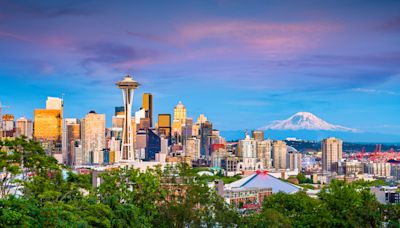Search results
Area codes. 206, 253, 360, 425, 564. FIPS code [6] 53-42660. The Seattle metropolitan area is an urban conglomeration in the U.S. state of Washington that comprises Seattle, its surrounding satellites and suburbs. The United States Census Bureau defines the Seattle–Tacoma–Bellevue, WA metropolitan statistical area as the three most populous ...
OMB's 2010 standards provide for the identification of the following types of statistical areas in California: Metropolitan Statistical Areas (MSA) have at least one urbanized area of 50,000 or more population, plus adjacent territory that has a high degree of social and economic integration with the core as measured by commuting ties.
- Overview
- Character of the city
Seattle, chief city of the state of Washington, U.S., seat (1853) of King county, the largest metropolis of the Pacific Northwest, and one of the largest and most affluent urban centres in the United States. A major port of entry and an air and sea gateway to Asia and Alaska, Seattle lies alongside Puget Sound, a deep inland arm of the northern Pacific Ocean, and is at the centre of a conurbation that is defined roughly by Everett to the north, Bellevue to the east, and Tacoma to the south.
The city was settled on November 13, 1851, at what is now West Seattle. It was relocated the following year to a site across Elliott Bay near a Duwamish Indian village. It owes its name to the Native American leader Seattle, chief of the Duwamish, Suquamish, and other tribes of the Puget Sound area. Areas of great natural beauty, including the densely forested Olympic Peninsula and the Cascade Range, surround the city. Its urban centre, dominated by tall skyscrapers that overlook Elliott Bay and enhanced by the city’s abundant parks and neighbourhoods, also offers a handsome prospect.
Seattle is a city of distinct neighbourhoods and urban districts that, though close to one another, change from one street to the next. Some neighbourhoods, notably those near the Duwamish Waterway to southwest of the city centre, are industrial in character, marked by rail yards, wharves, cranes, and low-income housing projects. Others, largely outside the city centre, are showcases for the opulence wrought by Seattle’s booming high-technology sector.
Seattle’s districts have a comfortably prosperous but not ostentatious feel, characterized by neat family homes and townhouses occupied by industrial workers, artists, academics, professionals, and that odd class of technology workers whom the novelist Douglas Coupland branded “microserfs.” The city is more closely connected to its downtown area than most of its counterparts in the American West, and considerable effort has been given to promoting the city centre as a place in which to live and work.
Seattle is a bustling place that thrives with industrial, commercial, and cultural activity around the clock. Its waters teem with great oceangoing ships, its streets with automobiles, its rail lines with transcontinental freighters and passenger trains, and its skies with aircraft of every description. Although the city’s image is of a financial and commercial centre, its people place great value on the arts, literature, sports, and other cultural activities; it boasts large arenas, multistory bookshops, dozens of museums and galleries, and countless examples of public art.
Exclusive academic rate for students! Save 67% on Britannica Premium.
Learn More
The city is densely populated. The metropolitan area, loosely defined, has grown to embrace once far-outlying satellites such as Everett and Renton. The shift from urban to bedroom communities is a consequence of several economic considerations, among them the rapid escalation within the city of the cost of family housing. Many Seattle workers have elected to commute from distant but more affordable towns beyond the city proper. By the early 21st century some 200,000 workers commuted to downtown Seattle from neighbouring communities, creating heavy traffic and disruptions on interstate and regional highways. Despite the high real estate prices, however, the inner city remained popular among certain groups, such as young renters.
Aug 20, 2023 · The city proper refers to the boundaries of the municipality of Seattle, while the metropolitan area includes surrounding suburbs and neighboring cities. While Seattle itself covers approximately 142.5 square miles, the metropolitan area extends much further, encompassing a total land area of over 8,000 square miles.
May 12, 2023 · The median home value in San Francisco far surpasses that of Seattle, making it a tough place for newcomers looking for affordable housing. Housing in both cities is expensive. Seattle, while also costly, is generally more affordable than San Francisco. However, with the rapid growth of its tech industry, housing prices have been on the rise ...
Seattle vs San Francisco cost of living. Rentals: According to RentCafe, the average rental monthly cost of a 700-square-foot apartment in Seattle as of February 2023 is $2,233. While a similar apartment in San Francisco will run you $3,313. That is a difference of about $1,100 monthly and over $13,000 a year in rental costs alone.
People also ask
Is Seattle a metropolitan area?
Where is Seattle located?
How big is Seattle?
Is Seattle a city?
Apr 7, 2022 · In fact, New York City has been the largest U.S. metropolitan area since the country's first census in 1790. The other long-time holders of top-three titles are Los Angeles and Chicago. To have a change in the top three, you have to go back to 1980 to have Los Angeles and Chicago trade places, with Chicago holding the number two spot.




